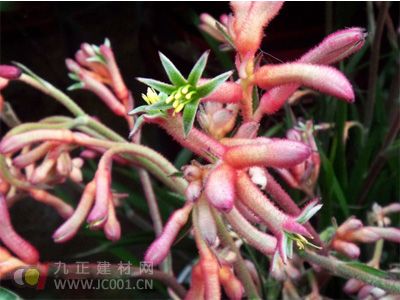Kangaroo flowers: "Kangarooopaws" is also known as "kangaroo claws" (named after the velvet-like fluff on the tubular shape, which is similar to the kangaroo claw). It is a high-grade cut flower variety, native to Australia, widely distributed in Western Australia. , grown in a variety of soil and climatic conditions. It is a perennial herb with two genera, 12 species and more than 40 horticultural species. It is Australia's second largest export flower and is exported to many parts of the world. It is also planted in the United States, Israel and Japan. The kangaroo flower is the most representative garden plant in Australia due to its unique shape and color, and it is also an excellent material for making dried flowers.
Kangaroo flower is still in the stage of introduction and development in China. Because of its long flowering period, unique flower pattern, colorful color, easy cultivation, and low management cost, it is gradually favored by domestic consumers. The market demand is increasing year by year. The main features and cultivation management techniques are now introduced as follows:

Morphological characteristics: Kangaroo flowers are perennial herbs, and the roots are fine but well developed. Fine fluff is attached to the stem, and the color is different depending on the variety. The stem has a thickness of about 0.4 cm. Leaves flat and clustered, linear-lanceolate, plant height 90 to 150 cm. The inflorescences are very long, with as many as 15 to 20 flowers. The flowers are numerous and fluffy, like the claws of a kangaroo, which is more adaptable.
Ecological habits:
(1) Kangaroo flower is a plant with short growth time. Generally, its growth potential begins to decline after 3-5 years of cultivation. Some breeds have the best growth for only one year. Adding organic fertilizer to the soil at the time of ramification can restore growth.
(2) The growth temperature is 18 to 28 ° C, and the winter temperature should not be lower than 5 ° C. When the temperature is higher than 30 ° C or lower than 5 ° C, the plant growth rate is slowed down or even stopped.
(3) The growth needs to be sunny and slightly resistant to yin.
(4) Hi fat.
(5) Hi sandy soil with good drainage.
(6) Strong branching.
(7) The flowering period is long and it can bloom from spring to summer.
(8) The disease is mainly black spot disease, and keeping the air dry is the key to preventing black spot disease. Kangaroo flowers prefer a well ventilated and breathable environment.
(9) The breeding method is that tissue culture and kangaroo flowers are difficult to propagate through seeds, and commercial seedlings are generally produced by tissue culture. Plants produced by tissue culture often show a high degree of growth, and the flowering color is basically the same, which is easy to produce and manage. Because kangaroo flowers have strong tillering characteristics, they can be sown when the plants grow too dense. At the time of ramets, the root incision should be sterilized with 800 times of carbendazim or 1000 times of chlorothalonil. After ramets, the water is poured into the conventional management after the sprouts begin to grow. This breeding method can keep the mother plants flowering in the current year but the plants with low reproductive coefficient and the plants recover slowly and are not suitable for scale cultivation.
Silicon Carbide,Silicon Carbide Grit ,Silicon Carbide Powder ,Silicone Carbide
Petroleum & Products Co., Ltd. , http://www.nbhardcoke.com